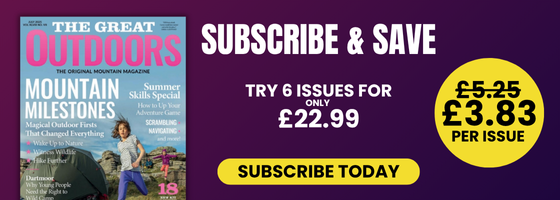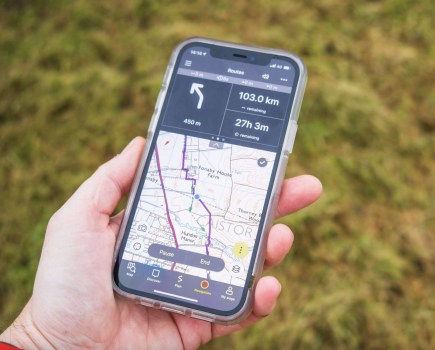A backpacking rucksack is a bit of a chicken-and-egg item. When packing, do you choose your other kit first, or your rucksack? Gear choice influences the rucksack you’ll need, and rucksack choice influences the gear you can comfortably carry. Put another way, choosing the right rucksack is an important decision!
Main image: An Atom Pack in The Rough Bounds of Knoydart | Credit: James Roddie
Most of us will end up with several packs and that’s because it’s hard to find one that will do everything well. Many TGO readers who are into backpacking are interested in multi-day routes with a rugged flavour… even if our lives don’t always allow for that! Some of us opt for a lightweight approach in the hills, but there’s always a place for bigger packs, especially in winter, or when planning for bucket list expeditions abroad.
Whatever your style, a backpacking pack must be big enough for hillwalking as well as food and camping equipment. It must be durable, comfortable to carry, and have convenient storage options such as side and front pockets, as well as attachment points for items such as ice axes and trekking poles. For winter use, you’ll likely want more durable materials, bigger capacity, and more strap attachment points for skis or snowshoes.
Beyond this, personal preference plays a hefty role, and that’s why we’ve selected rucksacks in a range of designs from minimalist, lightweight models to full-featured packs designed for massive loads. We have decided not to test 40L models (more suitable for overnight trips in good weather, or genuinely ultralight loads on longer trips) or anything bigger than 65L (likely too big for most people).
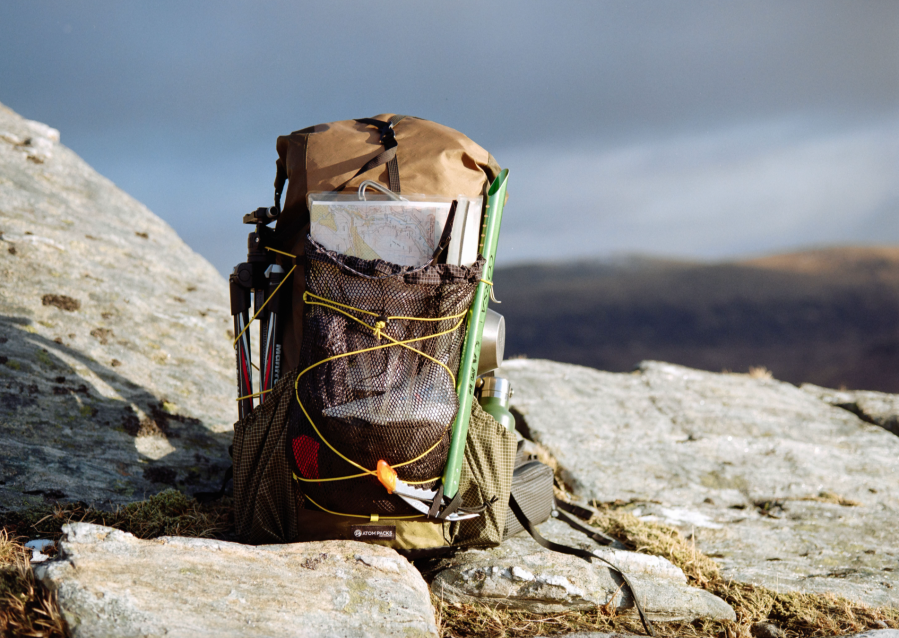
Our backpack testers live in Scotland and spend much of their time up big hills in all weathers. If a rucksack performs well for five days in the Cairngorms then it’ll likely do okay everywhere.
Why you can trust The Great Outdoors
The Great Outdoors is here to help you make the most of your time outside. We have been helping people to explore from sea to summit, valley to mountain top for over 40 years. Our gear tests remain completely impartial. If you are wary of websites that only review brands that advertise with them, or sceptical of social media accounts always singing the praises of their latest freebie, you’ve come to the right place! Our reviews rank #1 for rigour, trustworthiness, and independence, and our gear testing team is the most experienced in Britain. With over 200 years’ experience between us, we are professional mountain leaders and instructors, wildlife photographers and rangers, outdoor authors, guidebook writers and trail addicts. Find our more about how we test.
The best backpacking packs we’ve tested
| Quick List |
|---|
| Best in Test (women’s): Lowe Alpine Airzone Trek ND 43:50l (available from lowealpine.com) |
| Best in Test (men’s): Atom Packs The Notch (available from atompacks.co.uk – with US shipping options) |
| Greener Choice: Fjällräven Kajka 55 (available from fjallraven.com) |
| Best value: Highlander Novar 50+5l (available from highlander-outdoor.com) |
| Lightest in test (women’s): Osprey Renn 50l (available from osprey.com) |
Women's Best in Test
Lowe Alpine Airzone Trek ND 43:50l
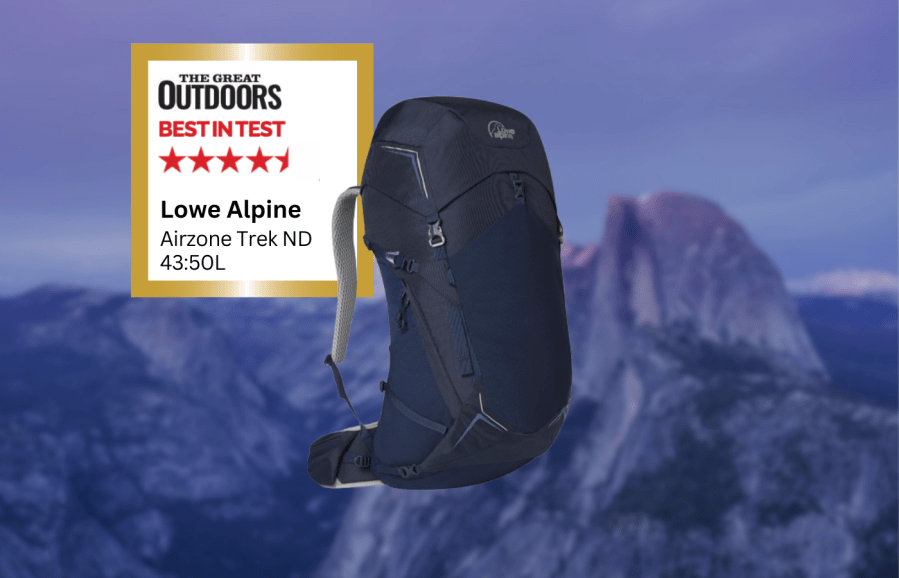
Lucy Wallace’s Best in Test
This roomy but low-volume pack has just one downside.- lightweight
- tough
- loads of handy features
- back system can’t be adjusted when bag is full
| Quick Specs |
|---|
| Price: $180 / £180 Weight: 1645g Materials: polyester/nylon mix (8% recycled content), PFAS free Features: adjustable Airzone back system, zipped hip and lid pocket, internal lid pocket, mesh side pockets, mesh stash pocket, internal divider, pouch for hydration system, side compression straps, zipped lower entry point and bottom straps, trekking pole TipGripper attachments Volume: 43l Sizes: one size, adjustable Women/Mens version: Airzone trek 45:55l lowealpine.com |
At just 43 litres, the Lowe Alpine Airzone Trek ND 43:50l was the lowest volume pack that I tested, but I found it to be easily roomy enough for an overnight camp, even with a winter sleeping bag. The lid is fixed, but has good extension capabilities, and there are plenty of compression straps for attaching external items if necessary. I would be confident using this in summer for a couple of nights camping (with careful packing) and for extended hut to hut journeys. Despite its relatively low weight, it is rugged, well made, and festooned with useful features, including an internal zipped lid pocket and a roomy external stash pocket.
My only complaint is the internal adjustment for the back length, which is a hook and loop tab system buried deep within the hydration pouch. It’s nigh on impossible to adjust when the pack is full, but it’s only when it is properly loaded that you can effectively tailor the fit. Getting the rucksack adjusted for the first time is frustratingly time consuming, because what should take seconds takes several minutes of faff.
Read more: Lucy’s full Lowe Alpine Airzone Trek ND 43:50l review
Men's Best in Test
Atom Packs The Notch

Alex Roddie’s Best in Test & Lightest in Test
Overall, this is a pack for the lightweight connoisseur and near perfect in its class.- unbeatable for lightweight backpacking
- configurable specs
- UK hand-made construction
- none
| Quick Specs |
|---|
| Price: £365 as configured, other configs from £265 (US shipping available) Weight: 950g as configured (50L, Medium) Materials: Ecopak EXPX200, 210D Robic Extreema, Dyneema mesh, 500D nylon back panel Features: fully configurable design, Y-shaped top strap for storage, compression cordage on front and sides, ice axe fastening Volume: 50 litres (40 also available) Closure: rolltop Back: fixed length, with internal frame sheet Hipbelt: cushioned, adjustable, 4 inches Pockets: 2 stretch mesh on harness, 2 side pockets, large front stretch mesh pocket, optional detachable hipbelt pockets Sizes: Torso size S—XL; hipbelt size XS—XXXL Women/Mens version: unisex atompacks.co.uk |
The Notch is the newest addition to the Atom Packs range, designed for lightweight but not ultralight three-season loads, and sits between existing models The Atom and The Prospector (formerly The Mo).
It’s a superb choice for three-season lightweight backpacking thanks to well-considered design choices, full customisation, and fantastic hand-made build quality from a UK brand. In use, I’ve found The Notch to be flawless. The minimalist design is well suited to experienced users; if you’re used to packs with more features it may need a short adjustment period, but the weight/capacity/comfort ratio really is unbeatable.
I’ve found it perfect for three-season trips with a bit more gear, or even lightweight winter missions. Even with heavier loads, I haven’t missed the load lifters. Plenty of external storage makes it great for carrying wet tents, ice axes, camera tripods, or multiple water bottles. Overall, this is a pack for the lightweight connoisseur and near perfect in its class.
Read more: Alex’s full Atom Packs The Notch review
Greener Choice
Fjällräven Kajka 55

Alex Roddie’s Greener Choice
Overall, despite the high weight, I think this is a great choice for backpacking in deep winter conditions. It’s overkill for most three-season backpacking, though.- superb adjustable harness for heavy loads
- great for winter or expedition use
- durable design
- loads of attachment points & pockets
- recycled fabrics
- complex design overkill for some uses
- very heavy
| Quick Specs |
|---|
| Price: $395.92 / £360 Weight: 2810g (S/M) Materials: Vinylon F, recycled 500D and 210D polyamide, traceable wood Features: zipped front access to main compartment, compression cordage on lid, dual ice axe fastenings, long side compression straps for attaching items to front, hydration sleeve, detachable rain cover, load lifters Volume: 55 litres (other capacities 35 to 100 litres) Closure: detachable zipped floating lid Back: adjustable, breathable mesh, with external birch wood frame Hipbelt: cushioned, adjustable, 6 inches Pockets: large lid pocket with additional internal and external zipped pockets, 4 side pockets (2 zipped), 2 zipped hipbelt pockets Sizes: S/M, M/L Women/Mens version: no fjallraven.com |
The Fjällräven Kajka 55 is a durable, full-featured pack designed for extended treks. It has an innovative external frame made from birch wood, said to reduce the product’s overall carbon footprint by 10%, and has the most adjustable harness of any men’s pack tested. The harness is the best-padded of any of the packs I tested, and combined with its high level of adjustability (as well as really long straps) you can achieve a superb level of comfort, no matter your body shape or size. It’s so comfortable that massive winter loads felt kilos lighter than expected.
I’ve found it fantastic for multi-day, high-level winter routes in the Cairngorms and Austrian Alps. Tent and snowshoes can be strapped easily to the outside. The wooden frame is one reason for its weight. Birch wood is heavier and bulkier than aluminium, but it’s more sustainable and performs well. It looks and feels good too. Another note on sustainability: the polyamide fabrics are recycled, and the product is made without PFAS.
Overall, despite the high weight, I think this is a great choice for backpacking in deep winter conditions. It’s overkill for most three-season backpacking, though.
Read more: Alex’s full Fjällräven Kajka 55 review
Recommended
Osprey Renn 50
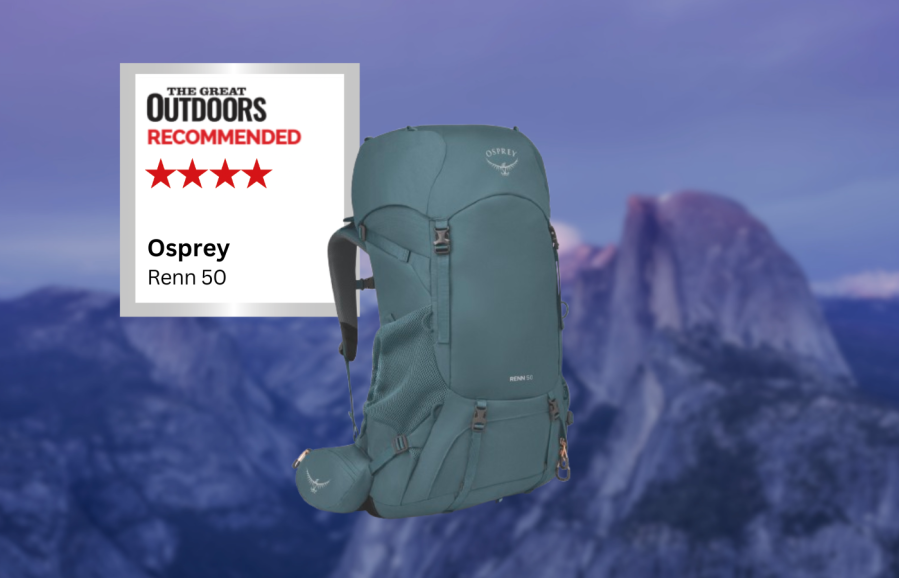
Lucy Wallace recommends
Overall, I found the pack comfortable to carry, with good weight distribution, and easy to pack.- tough
- lightweight
- less expensive than some
- fixed lid
- no internal lid pocket
- no large external stash pocket
| Quick Specs |
|---|
| Price: $180 / £170 Weight: 1626g Materials: 100% recycled 600D polyester, and recycled nylon; PFAS-free; DWR treatment Features: tensioned adjustable Airspeed back system, zipped hip and lid pocket, mesh side pockets, rain cover, internal divider, pouch for hydration system, side compression straps, zipped lower entry point and bottom straps Volume: 50l Sizes: one size, adjustable Women/Mens version: Rook 50 osprey.com |
The Osprey Renn 50 impressed me in several ways. At just over 1.6 kg, it’s lightweight compared to many competitors in its class, yet it doesn’t compromise on quality. The 600D polyester fabric is tough, and is made from entirely recycled sources, which makes it a reasonable environmental choice. The pack is significantly less expensive than Osprey’s other models, yet the build quality is exactly what you’d expect from a premium brand. Some of the weight savings come from its stripped-down design.
Overall, I found the pack comfortable to carry, with good weight distribution, and easy to pack. I unfastened the buckles on the internal divider to allow me to fill every corner of the base. There’s a zip for easy access to the bottom of the pack which is ideal if like me you tend to store the tent and other camping gear near the base.
With a 50-litre volume, I found the Renn 50 is ideal for an overnight camp or perhaps a couple of days if packing light. The side pockets are roomy, and the hip belt pockets are large enough to accommodate my mobile phone, even with its carry case.
Read more: Lucy’s full Osprey Renn 50l review
Best Value (women's)
Highlander Novar 50+5l
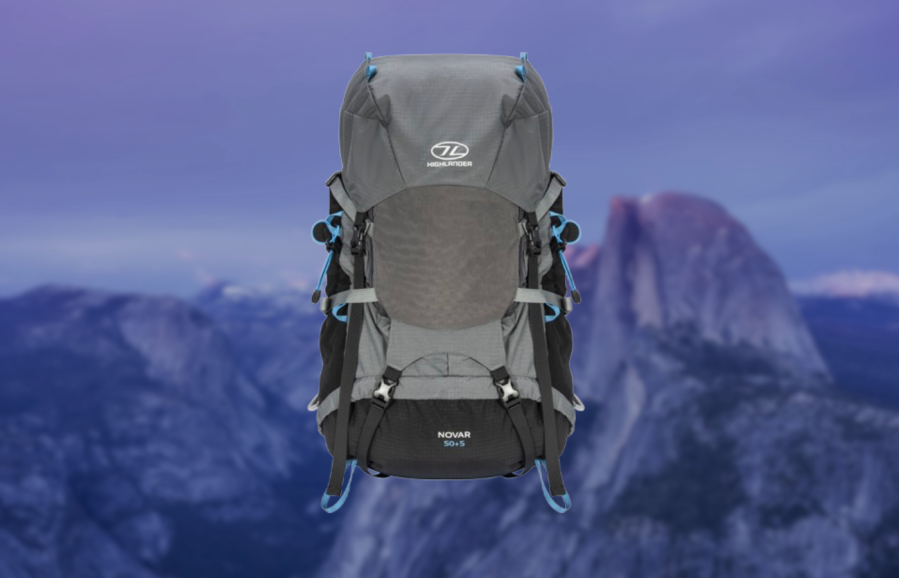
Lucy Wallace’s Best Value
It’s inevitable that there will be a trade-off between price and build quality, but it is impressive that Highlander have managed to include so many features for the price.- budget option
- less comfortable
- not as durable
| Quick Specs |
|---|
| Price: £95 (not available in the US) Weight: 1857g Materials: ripstop nylon Features: tensioned back system, zipped hip and lid pocket, mesh side pockets, mesh front pocket, rain cover, pouch for hydration system, side compression straps, zipped lower entry point and bottom straps Volume: 50+5l Sizes: one size, adjustable Women/Mens version: Unisex highlander-outdoor.com |
The Highlander Novar 50+5 comes with lots of useful features – mesh pockets on the side and front, and generous zipped hip pockets. There are even ice axe loops on the base, which means that it can be used in all seasons.
Inside the lid there is useful information about what to do in an emergency. At £95, it’s very much at the budget end of the market and will be attractive to Duke of Edinburgh participants. It’s inevitable that there will be a trade-off between price and build quality, but it is impressive that Highlander have managed to include so many features for the price.
The Novar has an old-fashioned adjustable back system based around two metal stays and buckles that allow the height of the shoulder straps to slide up and down the stays. It’s very simple to adjust and longitudinally rigid but has a habit of flexing and rocking when fully loaded, so is less stable and comfortable than others in this roundup.
Read more: Lucy’s full Highlander Novar 50+5l review
Best Value (men's)
Kelty Glendale 65l
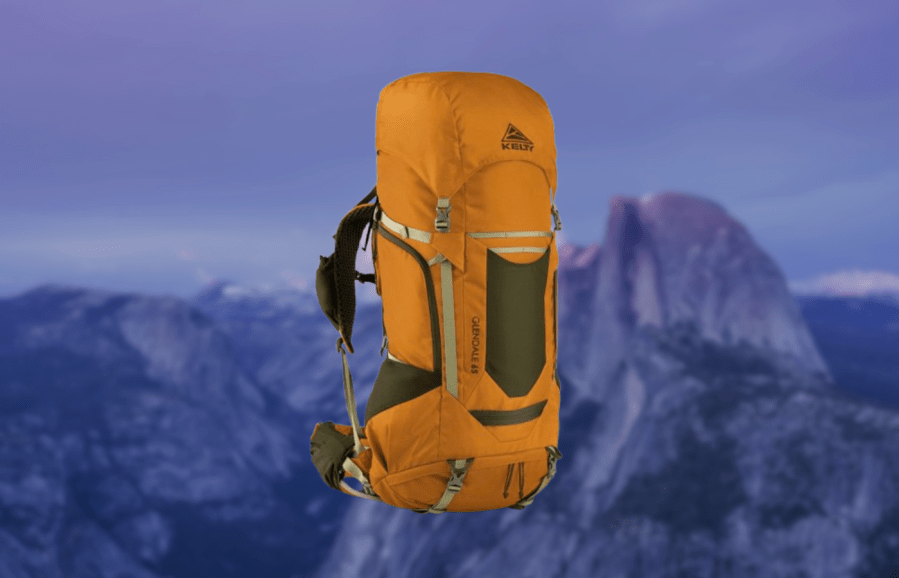
Alex Roddie’s Best Value
The value is great and it’s a durable pack for hard use. It should last well.- comfortable harness
- good value
- bottom straps for tent
- no spindrift collar on main compartment
- few attachment points for compression cordage
| Quick Specs |
|---|
| Price: $239.95 / £209.99 Weight: 2200g Materials: 300D Velocity (nylon), 600d Polyester Oxford Features: side access to main compartment, bottom access to main compartment, hydration sleeve, botom compression straps, large front grab handle, PFAS-free DWR, load lifters Volume: 65 litres Closure: zipped floating lid Back: adjustable, breathable mesh & ventilated, with external & internal frame Hipbelt: cushioned, adjustable, 5 inches Pockets: 2 stretch mesh on harness, large lid pocket with internal zipped mesh pocket, large front stretch mesh pocket, 3 side pockets (1 zipped), 2 hipbelt pockets (1 zipped, 1 open mesh) Sizes: one size Women/Mens version: yes kelty.com |
The Kelty Glendale 65L is a capacious and durable pack with a good range of features, best for traditional backpacking loads. However, its lack of spindrift collar and poor ice axe attachments make it less than perfect for winter use. The Glendale 65L has a traditional feature set, including compression straps at the bottom for attaching a tent, bottom zip access, a large floating lid, and beefy harness.
However, it also has asymmetric pockets – there’s a large side pocket on one side, while on the other a similar-shaped zip allows access to the main compartment. The hipbelt pockets are also asymmetric, with the one on the left side being mesh. You get side compression straps (extendable enough for poles but not a tent) and side bottle/wand pockets. The front mesh pocket is much smaller than on some of the other packs tested. The harness is highly adjustable and comfortable under heavy loads – a real plus point of this pack.
In use, I found the pack great for carrying as much gear as I could stuff in it, but the lack of a spindrift collar is a disappointment, which means your gear risks getting wet in rainy or snowy conditions. The ice axe attachments also feel much less secure than the usual design. Otherwise, the value is great, and it’s a durable pack for hard use. It should last well.
Read more: Alex’s full Kelty Glendale 65l review
Gregory Maven 55
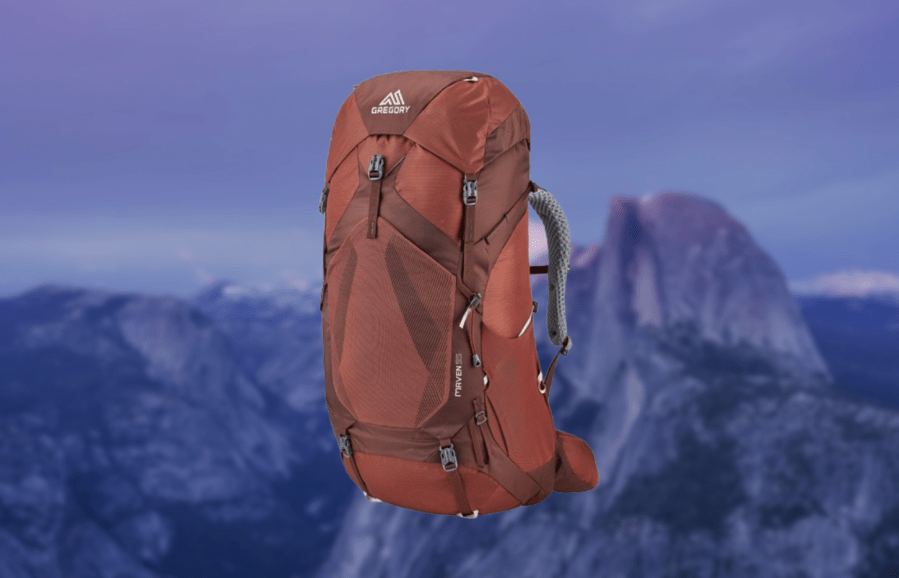
Lucy Wallace’s verdict
This pack is impressively spacious for its size and stated volume with a brilliant floating lid.- lightweight
- roomy
- well-featured
- two sizes available
- bulky shoulder straps
- lightweight fabric
| Quick Specs |
|---|
| Price: $194.96 / £220 – available from Cotswold Outdoor Weight: 1646g (S/M) Materials: 210/100D high density nylon, 50% recycled polyester Features: adjustable back system, zipped hip and lid pocket, mesh side pockets, rain cover, internal divider, pouch for hydration system, side compression straps, zipped lower entry point and bottom straps, floating lid Volume: 55l Sizes: XS/S and S/M Women/Mens version: Paragon range eu.gregorypacks.com |
The Gregory Maven 55 is a great mix of features and low weight, but it does come with a couple of caveats. This pack is impressively spacious for its size and stated volume. Its wide design makes packing easy, and it is loaded with generous pockets – mesh ones on the sides and front, plus two zipped pockets in the lid and extras on the hip belt.
The Maven is versatile enough for multi-day trips in the mountains, especially if you’re using lighter weight, less volumous gear. The pack comes in two back lengths, which should in theory allow for a tailored fit. The back system is easily adjustable in seconds thanks to a hook-and-loop fastening. However, the fit is where I ran into problems.
The shoulder straps are stiff and bulky and the contouring wasn’t quite right for me, and so were quite uncomfortable. Otherwise, the rest of the harness and back system performed well, transferring the load effectively to the hip belt.
Read more: Lucy’s full Gregory Maven 55 review
Rab Muon 50
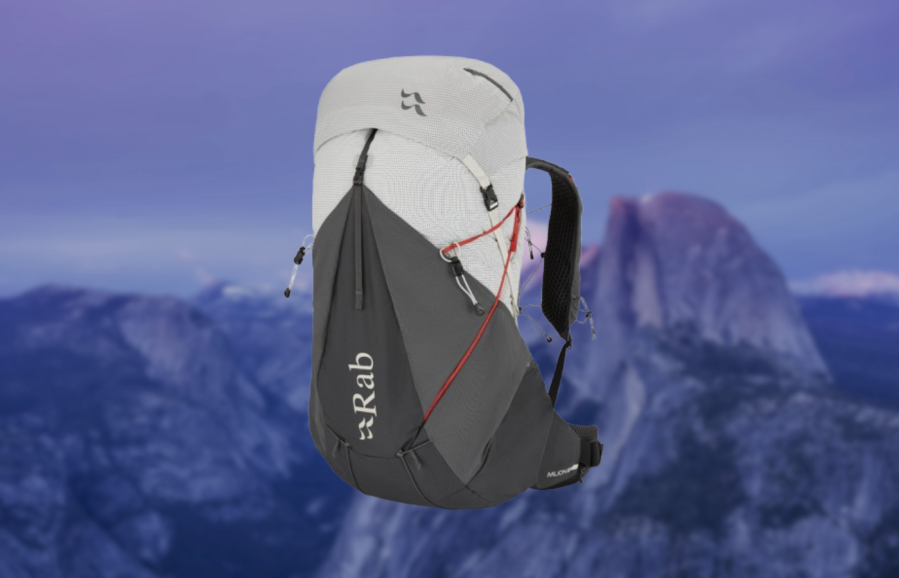
Alex Roddie’s verdict
If you’re looking for a pack that can do double duty, covering general backpacking with faster-paced adventures then this is worth a look – but try it on first.- comfy running-style harness
- good stability
- fairly light
- good value
- only one back length and non-adjustable
- bottom compression cords are awkward
- limited stretch in front pocket
- no hipbelt pockets
| Quick Specs |
|---|
| Price: $298 / £220 Weight: 1050g Materials: 85% recycled 100D high-tenacity ripstop nylon Features: running-style harness, hydration sleeve, 2x combined bottom straps and ice axe fastenings, side compression straps, cordage attachment points, load lifters Volume: 65 litres Closure: detachable zipped floating lid Back: fixed, ventilated, with internal frame Hipbelt: cushioned, ventilated, adjustable, 5 inches Pockets: 2 zipped stretch mesh on harness, large lid pocket, mesh pocket under lid, large front stretch mesh pocket, 2x large side mesh pockets Sizes: one size Women/Mens version: yes rab.equipment/uk |
The Rab Muon 50 is a pack inspired by running vests, but designed for lightweight backpacking. With a comfy harness that keeps the load close to the body, it’s good for scrambling and could be used for fastpacking. However, the non-adjustable back only comes in one length, and a few design niggles make it less than perfect.
That harness is the headline feature. It’s honestly pretty great, with broad shoulder straps and the ability to cinch it down over your chest for stability. This leads to a stable carry, especially on uneven ground or if moving fast. I also like the massive, zipped mesh pockets on the shoulder straps – the best of any pack I tested. However, the back length only comes in one size and it can’t be adjusted, so if you’re taller or shorter than average then this may not suit.
If you’re looking for a pack that can do double duty, covering general backpacking with faster-paced adventures then this is worth a look – but I recommend trying it on first. The value is good.
Read more: Alex’s full Rab Muon 50 review
Big Agnes Sweetwater UL 60L
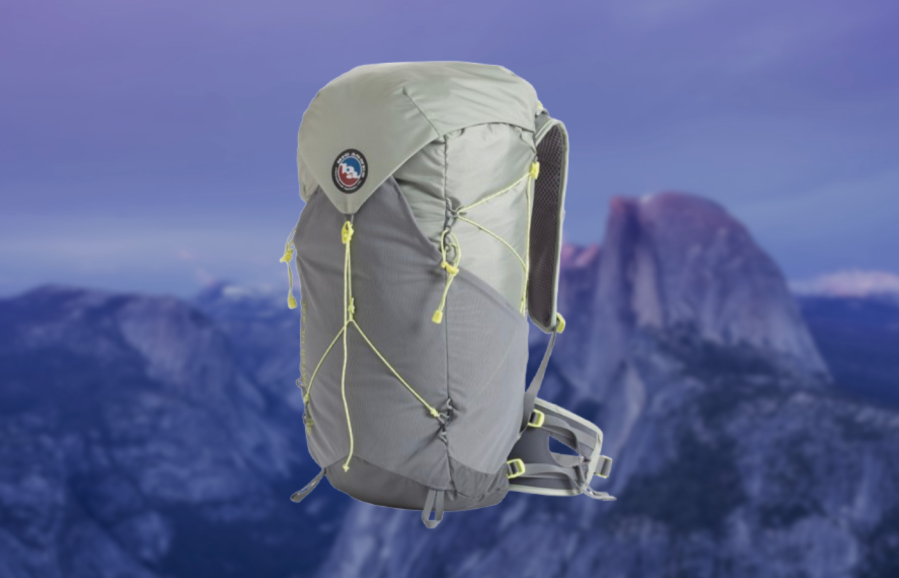
Alex Roddie’s verdict
The harness isn’t supportive enough for heavy loads and a few design quirks make this harder to recommend.- highly water-resistant design
- recycled materials
- uncomfortable harness
- unstable carry
- too much cordage in design
- no floating lid
- no hipbelt pockets
| Quick Specs |
|---|
| Price: $329.95 / £270 Weight: 1430g Materials: recycled 70D robic nylon ripstop made from fishing nets, recycled 210D robic nylon Oxford, 40D nylon ripstop lining, recycled EVA foam Features: running-style harness, detachable rain cover, hydration sleeve, compression cordage on sides & extra cordage attachment points, dual ice axe fastenings, water-resistant Ultra Tear Strength fabric coatings, load lifters Volume: 60 litres Closure: zipped lid Back: adjustable, ventilated, with internal injection-moulded frame Hipbelt: cushioned, ventilated, adjustable, 5 inches Pockets: 2 stretch mesh on harness, large lid pocket, large front stretch mesh pocket, 2 stretch mesh side pockets Sizes: S / M / L Women/Mens version: no bigagnes.com |
One of the biggest packs in this test, the Big Agnes Sweetwater UL 60L has a relatively minimal design with a running-inspired harness and large stretchy mesh pockets. However, the harness isn’t supportive enough for heavy loads and a few design quirks make this harder to recommend. Although the design is inspired by minimal, ultralight packs, it’s heavier than you might expect, and that’s partly thanks to the stiffened frame system. The harness is based on a running vest, with broad shoulder straps and double chest straps, but the shoulder straps are not as padded as I’d like and under extended use I found my shoulders getting sore.
On the plus side, the fabric is both recycled and has effective water-resistant coatings – I found it the most water-resistant pack tested (although it’s still not fully waterproof).
Read more: Alex’s full Big Agnes Sweetwater review
How we test
Lucy Wallace
These rucksacks were tested in a variety of conditions on overnight camps in Scotland and Wales. Weights supplied are from Lucy’s home scales.
Alex Roddie
Alex tested these packs on a variety of multi-day backpacking routes in the Scottish Highlands and Lowlands as well as the Austrian Alps. They were used from autumn through to spring in a broad range of conditions. Weights are as measured on Alex’s digital scale.
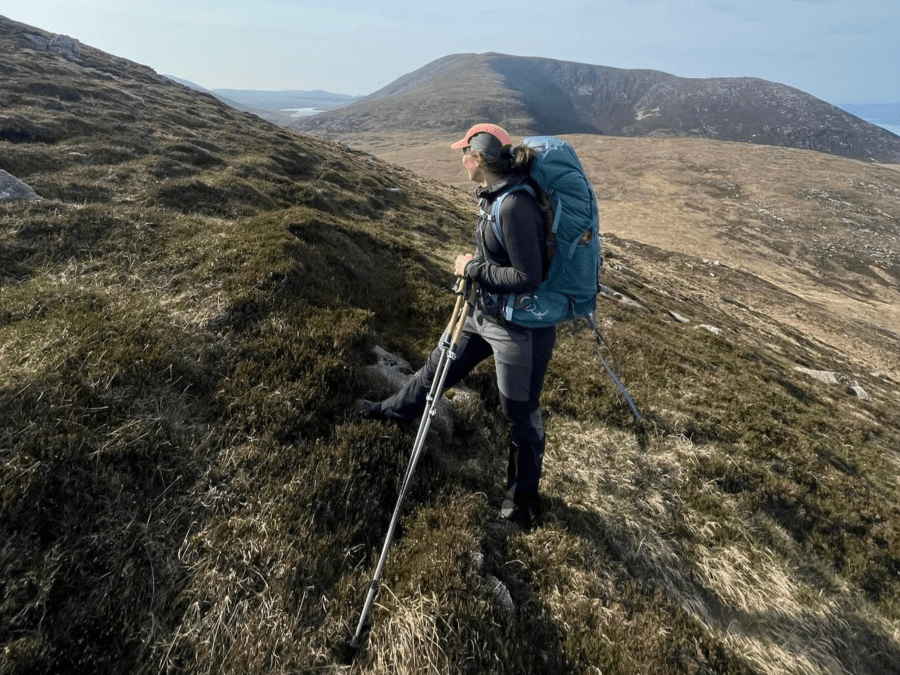
Key features of the best backpacking packs
Back System
This is designed to transfer weight from the shoulders to the hips. An adjustable system helps achieve a customised fit. Many are designed to allow airflow to help keep the back cool.
Shoulder straps
Padded and contoured straps that prevent chafing are ideal for heavier loads. Adjustable straps with buckles on the top of the shoulders and under the arms help pull the rucksack closer to the body. A chest strap adds stability and should be height adjustable to suit different body shapes.
Hip belt
This carries most of the load and should be padded and easy to adjust. Pockets on the hip belt are perfect for small essentials.
Top pocket/lid
Covers the opening to the main compartment and typically contains one or more zipped pockets. The lid may be fixed, extendable, or floating, (meaning it can be removed entirely).
External pockets
Useful for storing items needed quickly, such as water bottles or spare layers. These may be on the side, or the main body of the rucksack.
Compression straps
Useful for securing external items like trekking poles or roll mats. Side straps are helpful for compressing the bag when partially full.
Rain cover
An adjustable cover that attaches to the outside of the bag to provide some protection from the elements. Rain covers are not fully waterproof and often come loose in high winds.
Volume
A 50-litre pack works well for shorter trips with lightweight gear, but a larger volume may be better suited to extended trips or bulkier equipment.
Materials
Polyester and nylon are lightweight and strong. Look for ripstop and high denier fabrics for durability. Recycled polyester is preferable if the rucksack lasts, but it’s not easily recycled again. Of course, even the best backpacking packs do need some TLC, especially after heavy use. Find out how to clean your backpack and how to re-proof your backpack so they’ll last as long in the hills as you.
Fit
Fit is critical, so check brand size guides and measure yourself. Try the loaded pack on and adjust the straps. It should feel stable, with the centre of gravity near the hips and no gaps at the shoulders.
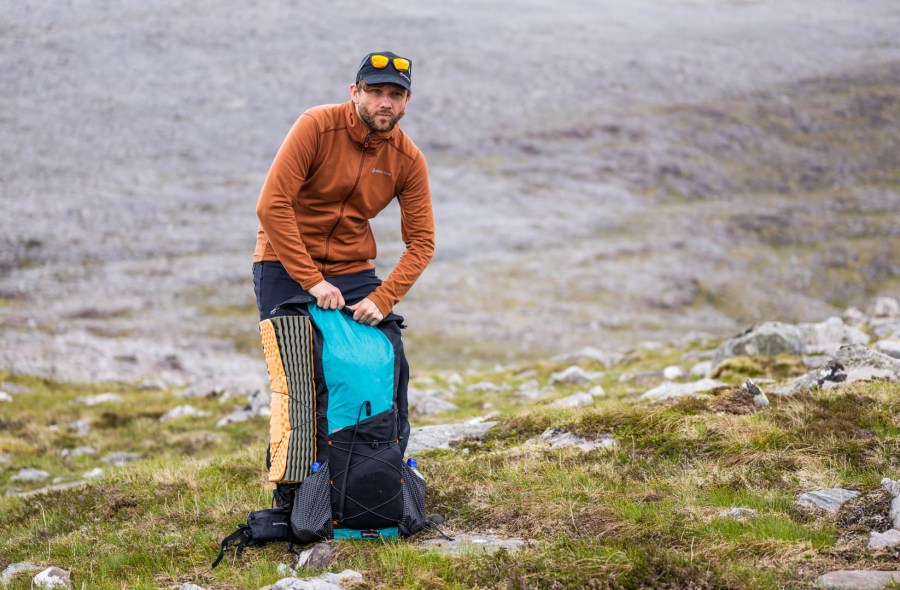
How to fit a backpack
Once you’ll be carrying gear for camping larger packs are needed and the fit becomes important. A properly fitted and adjusted pack should mean most of the weight is carried on your hips not your shoulders. To do this the back length must be correct. Too short and the hipbelt will ride too high and won’t support much weight without cutting painfully into your stomach. Too long and the top of the shoulder straps will be above your shoulders, making the pack unstable, or the hipbelt too low to fasten tightly. In either case the pack will be uncomfortable to carry.
To find the right fit packs should be tried on fully loaded. It’s worth taking time to do this. A comfortable pack makes a huge difference to the enjoyment of a backpacking trip. Most packs come with specific fitting instructions and it’s always worth following these.
These are the basics:
- The key for the correct fit is the length of your back, measured from the base of the neck to the upper hipbone (technically from the seventh cervical vertebra to the top of the iliac crest). Having someone measure your back length with a flexible tape measure is the best way to find this. Your actual height is not important – some people have long legs and short backs, other have short legs and long backs.
- Packs generally come in 5 centimetre/2-inch increments. If you’re on the edge of two sizes it’s best to try both on to see which feels best.
- The padded section of the shoulder straps should curve under your arms leaving only a relatively short length of webbing for adjustment. How far apart the shoulder straps are at the top matters. Too wide and the straps can feel as though they’re falling off. Some packs have shoulder straps that can be adjusted for width. Women’s packs generally have shoulder straps that are closer together at the top than men’s packs.
- If the back length is right the hipbelt should wrap round your hips with the upper edge about 2.54 centimetres/1 inch above your hipbones so that the weight is carried comfortably on your hips.
- The padded sections of the belt should come round the side of your hips to help spread the load. Some packs have hipbelts that allow you to adjust the length of the padded sections. Many hipbelts are shaped so they curve over your hips.
- Most packs have narrow straps that rise from the upper shoulder straps to the top of the pack back. These load lifter or top tension straps are designed to pull the load in over your shoulders to increase stability and to lift the shoulder straps off the top of the shoulders and transfer the weight to the collarbones. Loosening and tightening these straps while walking can adjust the weight between the hipbelt and the shoulder straps. To be effective load lifter straps should rise at an angle of around 45 degrees.
- The final item to adjust is the sternum strap that runs across the top of the chest. This pulls the shoulder straps inwards and increases stability. Sternum straps can be moved up and down the shoulder straps. To be effective and comfortable they should sit high up, just below your neck. They’re not essential but can be very useful when scrambling or hiking on rough terrain.
Learn more about how to choose a backpack from Equipment Editor Chris Townsend. Only when you have a pack that fits your back should the features of the pack be considered. It doesn’t matter what pockets, compartments, straps or other features a pack has if it doesn’t fit.




